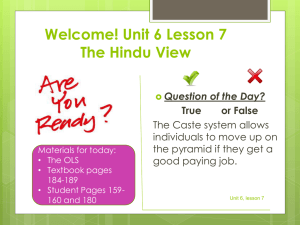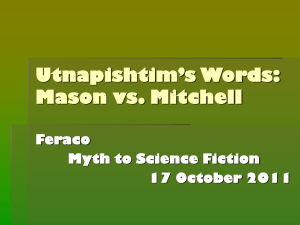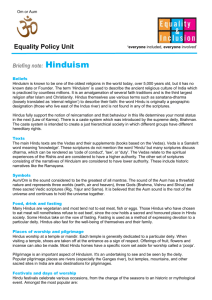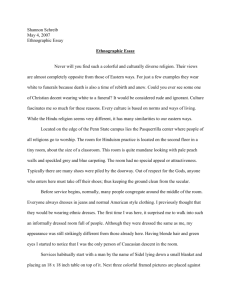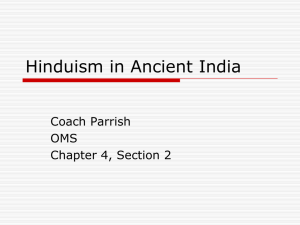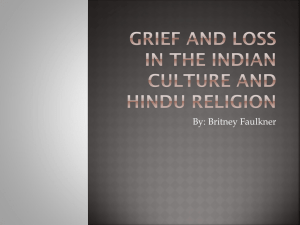The following are selections from Darśan: Seeing the Divine Image
advertisement
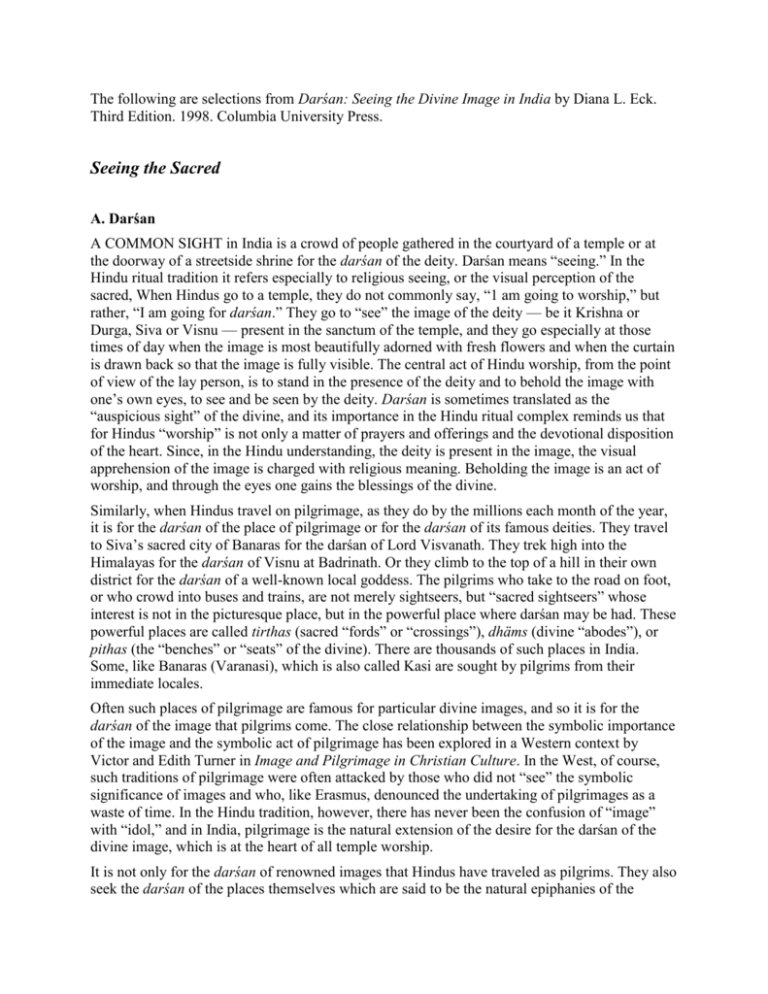
The following are selections from Darśan: Seeing the Divine Image in India by Diana L. Eck. Third Edition. 1998. Columbia University Press. Seeing the Sacred A. Darśan A COMMON SIGHT in India is a crowd of people gathered in the courtyard of a temple or at the doorway of a streetside shrine for the darśan of the deity. Darśan means “seeing.” In the Hindu ritual tradition it refers especially to religious seeing, or the visual perception of the sacred, When Hindus go to a temple, they do not commonly say, “1 am going to worship,” but rather, “I am going for darśan.” They go to “see” the image of the deity — be it Krishna or Durga, Siva or Visnu — present in the sanctum of the temple, and they go especially at those times of day when the image is most beautifully adorned with fresh flowers and when the curtain is drawn back so that the image is fully visible. The central act of Hindu worship, from the point of view of the lay person, is to stand in the presence of the deity and to behold the image with one’s own eyes, to see and be seen by the deity. Darśan is sometimes translated as the “auspicious sight” of the divine, and its importance in the Hindu ritual complex reminds us that for Hindus “worship” is not only a matter of prayers and offerings and the devotional disposition of the heart. Since, in the Hindu understanding, the deity is present in the image, the visual apprehension of the image is charged with religious meaning. Beholding the image is an act of worship, and through the eyes one gains the blessings of the divine. Similarly, when Hindus travel on pilgrimage, as they do by the millions each month of the year, it is for the darśan of the place of pilgrimage or for the darśan of its famous deities. They travel to Siva’s sacred city of Banaras for the darśan of Lord Visvanath. They trek high into the Himalayas for the darśan of Visnu at Badrinath. Or they climb to the top of a hill in their own district for the darśan of a well-known local goddess. The pilgrims who take to the road on foot, or who crowd into buses and trains, are not merely sightseers, but “sacred sightseers” whose interest is not in the picturesque place, but in the powerful place where darśan may be had. These powerful places are called tirthas (sacred “fords” or “crossings”), dhäms (divine “abodes”), or pithas (the “benches” or “seats” of the divine). There are thousands of such places in India. Some, like Banaras (Varanasi), which is also called Kasi are sought by pilgrims from their immediate locales. Often such places of pilgrimage are famous for particular divine images, and so it is for the darśan of the image that pilgrims come. The close relationship between the symbolic importance of the image and the symbolic act of pilgrimage has been explored in a Western context by Victor and Edith Turner in Image and Pilgrimage in Christian Culture. In the West, of course, such traditions of pilgrimage were often attacked by those who did not “see” the symbolic significance of images and who, like Erasmus, denounced the undertaking of pilgrimages as a waste of time. In the Hindu tradition, however, there has never been the confusion of “image” with “idol,” and in India, pilgrimage is the natural extension of the desire for the darśan of the divine image, which is at the heart of all temple worship. It is not only for the darśan of renowned images that Hindus have traveled as pilgrims. They also seek the darśan of the places themselves which are said to be the natural epiphanies of the divine: the peaks of the Himalayas, which are said to be the abode of the gods; the river Ganga, which is said to fall from heaven to earth; or the many places which are associated with the mythic deeds of gods and goddesses, heroes and saints. In addition to the darśan of temple images and sacred places, Hindus also value the darśan of holy persons, such as sants (“saints”), sadhus (“holy men”), and sannyãsins (“renouncers”). When Mahatma Gandhi traveled through India, tens of thousands of people would gather wherever he stopped in order to “take his darśan.” Even if he did not stop, they would throng the train stations for a passing glimpse of the Mahatma in his compartment. Similarly, when Swami Karpatri, a well-known sannyasin who is also a writer and political leader, would come to Varanasi to spend the rainy season “retreat” period, people would flock to his daily lectures not only to hear him, but to see him. However, even an ordinary sannyasin or sadhu is held in esteem in traditional Hindu culture. He is a living symbol of the value placed upon renunciation, and he is a perpetual pilgrim who has left home and family for a homeless life. Villagers are eager for the darśan of such a person, approaching him with reverence and giving him food and hospital ity. In The Ochre Robe, Agehananda Bharati writes, “There is absolutely no parallel to the conception of darśan in any religious act in the West…” In popular terminology, Hindus say that the deity or the sadhu “gives darśan (darśan dena is the Hindi expression), and the people “take darśan (darśan lena). What does this mean? What is given and what is taken? The very expression is arresting, for “seeing” in this religious sense is not an act which is initiated by the worshiper. Rather, the deity presents itself to be seen in its image, or the sadhu gives himself to be seen by the villagers. And the people “receive” their darśan. One might say that this “sacred perception,” which is the ability truly to see the divine image, is given to the devotee, just as Arjuna is given the eyes with which to see Krishna in the theophany described in the Bhagavad Gita. The prominence of the eyes of Hindu divine images also reminds us that it is not only the worshiper who sees the deity, but the deity sees the worshiper as well. The contact between devotee and deity is exchanged through the eyes. It is said in India that one of the ways in which the gods can be recognized when they move among people on this earth is by their unblinking eyes. Their gaze and their watchfulness is uninterrupted. Jan Gonda, in his detailed monograph Eye and Gaze in the Veda, has enumerated the many ways in which the powerful gaze of the gods was imagined and expressed even in a time before actual images of the gods were crafted. The eyes of Surya or Agni or Varuna are powerful and all-seeing, and the gods were entreated to look upon men with a kindly eye. In the later Hindu tradition, when divine images began to be made, the eyes were the final part of the anthropomorphic image to be carved or set in place. Even after the breath of life (prana) was established in the image there was the ceremony in which the eyes were ritually opened with a golden needle or with the final stroke of a paintbrush. This is still common practice in the consecration of images, and today shiny oversized enamel eyes may be set in the eye- sockets of the image during this rite. The gaze which falls from the newly-opened eyes of the deity is said to be so powerful that it must first fall upon some pleasing offering, such as sweets, or upon a mirror where it may see its own reflection. More than once has the tale been told of that powerful gaze falling upon some unwitting bystander, who died instantly of its force. Hindu divine images are often striking for their large and conspicuous eyes. The famous image of Krishna Jagannath in Puri has enormous saucer-like eyes. Siva and Ganesa are often depicted with a third vertical eye, set in the center of the forehead. Brahma, inheriting the name “Thousand-Eyes” from Indra, is sometimes depicted with eyes all over his body, like leopard spots. While it would take us too far afield to explore the many dimensions of eye- power in the Hindu tradition, it is important for this study of the divine image to recognize that just as the glance of the inauspicious is thought to be dangerous and is referred to as the “evil eye,” so is the glance of the auspicious person or the deity held to be profit able. When Hindus stand on tiptoe and crane their necks to see, through the crowd, the image of Lord Krishna, they wish not only to “see,” but to be seen. The gaze of the huge eyes of the image meets that of the worshiper, and that exchange of vision lies at the heart of Hindu worship. D. The Image of God The vivid variety of Hindu deities is visible everywhere in India. Rural India is filled with countless wayside shrines. In every town of some size there are many temples, and every major temple will contain its own panoply of shrines and images. One can see the silver mask of the goddess Durga, or the stone shaft of the Siva linga, or the four-armed form of the god Visnu. Over the doorway of a temple or a home sits the plump, orange, elephant-headed Ganesa or the benign and auspicious Laksmi. Moreover, it is not only in temples and homes that one sees the images of the deities. Small icons are mounted at the front of taxis and buses. They decorate the walls of tea stalls, sweet shops, tailors, and movie theatres. They are painted on public buildings and homes by local folk artists. They are carried through the streets in great festival processions. It is visibly apparent to anyone who visits India or who sees some thing of India through the medium of film that this is a culture in which the mythic imagination has been very generative. The images and myths of the Hindu imagination constitute a basic cultural vocabulary and a common idiom of discourse. Since India has “written” prolifically in its images, learning to read its mythology and iconography is a primary task for the student of Hinduism. In learning about Hinduism, it might be argued that perhaps it makes more sense to begin with Ganesa the elephant-headed god who sits at the thresholds of space and time and who blesses all beginnings, and then proceed through the deities of the Hindu pantheon, rather than to begin with the Indus Valley civilization and proceed through the ages of Hindu history. Certainly for a student who wishes to visit India, the development of a basic iconographic vocabulary is essential, for deities such as the monkey Hanuman or the fierce Kali confront one at every turn. When the first European traders and travelers visited India, they were astonished at the multitude of images of the various deities which they saw there. They called them “idols” and described them with combined fascination and repugnance. For example, Ralph Fitch, who traveled as a merchant through north India in the 1500s writes of the images of deities in Banaras: “Their chiefe idols bee blacke and evill favoured, their mouths monstrous, their eares gilded and full of jewels, their teeth and eyes of gold, silver and glasse, some having one thing in their hands and some another.” Fitch had no interpretive categories, save those of a very general Western Christian background, with which to make sense of what he saw. Three hundred years did little to aid interpretation. When M. A. Sherring lived in Banaras in the middle of the 1800s he could still write, after studying the city for a long time, of “the worship of uncouth idols, of monsters, of the linga and other indecent figures, and of a multitude of grotesque, ill-shapen, and hideous objects.” When Mark Twain traveled through India in the last decade of the nineteenth century, he brought a certain imaginative humor to the array of “idols” in Banaras, but he remained without what Arnheim would call “manageable models” for placing the visible data of India in a recognizable context. Of the “idols” he wrote, “And what a swarm of them there is! The town is a vast museum of idols — and all of them crude, misshapen, and ugly. They flock through one’s dreams at night, a wild mob of nightmares.” Without some interpretation, some visual hermeneutic, icons and images can be alienating rather than enlightening. Instead of being keys to understanding, they can kindle xenophobia and pose barriers to understanding by appearing as a “wild mob of night mares,” utterly foreign to and unassimilable by our minds. To understand India, we need to raise our eyes from the book to the image, but we also need some means of interpreting and comprehending the images we see. The bafflement of many who first behold the array of Hindu images springs from the deeprooted Western antagonism to imaging the divine at all. The Hebraic hostility to “graven images” ex pressed in the Commandments is echoed repeatedly in the Hebrew Bible: “You shall not make for yourself a graven image, or any like ness of anything that is in heaven above, or that is in the earth beneath, or that is in the water under the earth.” The Hebraic resistance to imaging the divine has combined with a certain distrust of the senses in the world of the Greek tradition as well. While the Greeks were famous for their anthropomorphic images of the gods, the prevalent suspicion in the philosophies of classical Greece was that “what the eyes reported was not true.” Like those of dim vision in Plato’s cave, it was thought that people generally accept the mere shadows of reality as “true.” Nevertheless, if dim vision described human perception of the ordinary world, the Greeks continued to use the notion of true vision to describe wisdom, that which is seen directly in the full light of day rather than obliquely in the shadowy light of the cave. Arnheim writes, “The Greeks learned to distrust the senses, but they never forgot that direct vision is the first and final source of wisdom. They refined the techniques of reasoning, but they also believed that, in the words of Aristotle, ‘the soul never thinks without an image.’ “ On the whole, it would be fair to say that the Western traditions, especially the religious traditions of the “Book” — Judaism, Christianity, and Islam — have trusted the Word more than the Image as a mediator of the divine truth. The Qur’an and the Hebrew Bible are filled with injunctions to “proclaim” and to “hear” the word. The ears were somehow more trustworthy than the eyes. In the Christian tradition this suspicion of the eyes and the image has been a particularly Protestant position. And yet the visible image has not been without some force in the religious thinking of the West. The verbal icon of God as “Father” or “King” has had considerable power in shaping the Judeo Christian religious imagination. The Orthodox Christian traditions, after much debate in the eighth and ninth centuries, granted important place to the icons as those “windows” through one might look toward God. They were careful, however, to say that the icon should not be realistic” and should be only two dimensional. In the Catholic tradition as well, the art and iconography, especially of Mary and the saints, has had a long and rich history. And all three traditions of the “Book” have developed the art of embellishing the word into a virtual icon in the elaboration of calligraphic and decorative arts. Finally, it should be said that there is a great diversity within each of these traditions. The Mexican villager who comes on his knees to the Virgin of Guadalupe, leaves a bundle of beans, and lights a candle, would no doubt feel more at home in a Hindu temple than in a stark, white New Eng land Protestant church. Similarly, the Moroccan Muslim woman who visits the shrines of Muslim saints, would find India less foreign than did the eleventh century Muslim scholar Alberuni, who wrote that “the Hindus entirely differ from us in every respect.” Worshiping as God those ‘things” which are not God has been despised in the Western traditions as ‘idolatry,” a mere bowing down to “sticks and stones.” The difficulty with such a view of idolatry, however, is that anyone who bows down to such things clearly does not understand them to be sticks and stones, No people would identify themselves as “idolators,” by faith. Thus, idolatry can be only an outsider’s term for the symbols and visual images of some other culture. Theodore Roszak, writing in Where the Wasteland Ends, locates the “sin of idolatry” precisely where it belongs: in the eye of the beholder. In beginning to understand the consciousness of the Hindu worshiper who bows to “sticks and stones,” an anecdote of the Indian novelist U. R. Anantha Murthy is provocative. He tells of an artist friend who was studying folk art in rural north India. Looking into one hut, he saw a stone daubed with red kunkum powder, and he asked the villager if he might bring the stone outside to photograph it. The villager agreed, and after the artist had photographed the stone he realized that he might have polluted this sacred object by moving it outside. Horrified, he apologized to the villager, who replied, ‘It doesn’t matter. I will have to bring another stone and anoint kunkum on it.” Anantha Murthy comments, “Any piece of stone on which he put kunkum became God for the peasant. What mattered was his faith, not the stone.” We might add that, of course, the stone matters too. If it did not, the peasant would not bother with a stone at all. Unlike the zealous Protestant missionaries of a century ago, we are not much given to the use of the term “idolatry” to condemn what “other people” do. Yet those who misunderstood have still left us with the task of understanding, and they have raised an important and subtle issue in the comparative study of religion: What is the nature of the divine image? Is it considered to be intrinsically sacred? Is it a symbol of the sacred? A mediator of the sacred? How are images made, consecrated, and used, and what does this tell us about the way they are understood? But still another question remains to be addressed before we take up these topics. That is the question of the multitude of images. Why are there so many gods? E. The Polytheistic Imagination It is not only the image-making capacity of the Hindu imagination that confronts the Western student of Hinduism, but the bold Hindu polytheistic consciousness. Here too, in attempting to understand another culture, we discover one of the great myths of our own: the myth of monotheism. Myths are those “stories” we presuppose about the nature of the world and its structures of meaning. Usually we take our own myths so much for granted that it is striking to recognize them as “myths” which have shaped not only our religious viewpoint, but our ways of knowing. Even Westerners who consider themselves to be secular participate in the myth of monotheism: that in matters of ultimate importance, there is only One — one God, one Book, one Son, one Church, one Seal of the Prophets, one Nation under God. The psychologist James Hillman speaks of a “monotheism of consciousness” which has shaped our very habits of thinking, so that the autonomous, univocal, and independent personality is considered healthy; single-minded decision-making is considered a strength; and the concept of the in dependent ego as “number one” is considered normal . In entering into the Hindu world, one confronts a way of thinking which one might call “radically polytheistic,” and if there is any “great divide” between the traditions of India and those of the West, it is in just this fact. Some may object that India has also affirmed Oneness as resolutely and profoundly as any culture on earth, and indeed it has. The point here, however, is that India’s affirmation of Oneness is made in a context that affirms with equal vehemence the multitude of ways in which human beings have seen that One ness and expressed their vision. Indian monotheism or monism cannot, therefore, be aptly compared with the monotheism of the West. The statement that “God is One” does not mean the same thing in India and the West. At virtually every level of life and thought, India is polycentric and pluralistic. India, with what E. M. Forster called “her hundred mouths,” has been the very exemplar of cultural multiplicity. There is geographical and racial diversity from the Pathans of the Punjab to the Dravidians of Tamilnad. There are fourteen major language groups. There is the elaborate social diversity of the caste system. There is the religious diversity of major religious traditions: the Hindus, Muslims, Sikhs, Christians, Buddhists, Jams, and Parsis. (As Mark Twain quipped in his diaries from India, “In religion, all other countries are paupers. India is the only millionaire.” even within what is loosely called there are many sectarian strands: Vaisnavas, Saivas, Saktas, Smartas, and others. Note that the very term Hinduism refers only to the “ism” of the land which early Muslims called “Hind,” literally, the land beyond the Indus. Hinduism is no more, no less than the “ism” of India. The diversity of India has been so great that it has sometimes been difficult for Westerners to recognize in India any underlying unity As the British civil servant John Strachey put it, speaking to an audience at Cambridge University in 1859, “There is no such country, and this is the first and most essential fact about India that can be learned Seeking recognizable signs of unity — common language, unifying religion, shared historical tradition — he did not see them in India. In part, the unity of India, which Strachey and many others like him could not see, is in its cultural genius for embracing diversity, so that diversity unites, rather than divides. For example, there are the six philosophical traditions recognized as “orthodox.” But they are not called “systems” in the sense in which we use that term. Rather, they are darśanas. Here the term means not the “seeing” of the deity, but the “seeing of truth.” There are many such darśanas many “points of view” or “perspectives” on the truth. And although each has its own starting point, its own theory of causation, its own accepted enumeration of the means by which one can arrive at valid knowledge, these “ways of seeing” share a common goal — liberation — and they share the understanding that all their rivals are also “orthodox.” Philosophical discourse, therefore, takes the form of an ongoing dialogue, in which the views of others are explained so that one can counter them with one’s own view. Any “point of view” implicitly assumes that another point of view is possible. Moving from the philosophical to the social sphere, there is the well-known diversity of interlocking and interdependent caste groups. On a smaller scale, there is the polycentric system of family authority, which is integral to the extended, joint family. Here not only the father and mother, but grandparents, aunts, and uncles serve as different loci of family authority and fulfill different needs. Not unrelated to this complex polycentrism of the social structure is the polycentric imaging of the pantheon of gods and goddesses. Just as the social and institutional structures of the West have tended historically to mirror the patriarchal monotheism of the religious imagination, so have the social structure and family structure of India displayed the same tendency toward diversification that is visible in the complex polytheistic imagination. At times, the ordering of the diverse parts of the whole seems best de scribed as hierarchical, yet it is also true that the parts of the whole are knotted together in interrelations that seem more like a web than a ladder. The unity of India, both socially and religiously, is that of a complex whole. In a complex whole, the presupposition upon which oneness is based is not unity or sameness, but interrelatedness and diversity. The German Indologist Betty Heimann uses the image of a crystal to describe this multiplex whole: Whatever Man sees, has seen or will see is just one facet only of a crystal. Each of these facets from its due angle provides a correct viewpoint, but none of them alone gives a true all-comprehensive picture. Each serves in its proper place to grasp the Whole, and all of them combined come nearer to its full grasp. However, even the sum of them all does not exhaust all hidden possibilities of approach The diversity of deities is part of the earliest Vedic history of the Hindu tradition. In the Rg Veda, the various gods are elaborately praised and in their individual hymns, each is praised as Supreme. Indra may in one hymn be called the “Sole Sovereign of Men and of Gods,” and in the next hymn Varuna may be praised as the “Supreme Lord, Ruling the Spheres.” Max Muller, who was the first great Western interpreter of the Vedas, searched for an adequate term to describe the religious spirit of this literature. It is not monotheism, although there certainly is a vision of divine supremacy as grand as the monotheistic vision. It is not really polytheism, at least if one understands this as the worship of many gods, each with partial authority and a limited sphere of influence. He saw that these Western terms did not quite fit the Hindu situation. To de scribe the deities of Hinduism, Muller coined the word kathenotheism — the worship of one god at a time. Each is exalted in turn. Each is praised as creator, source, and sustainer of the universe when one stands in the presence of that deity. There are many gods, but their multiplicity does not diminish the significance or power of any of them. Each of the great gods may serve as a lens through which the whole of reality is clearly seen. The spirit which Muller saw in the Vedic hymns continues to be of great significance in many aspects of Indian religious life. To celebrate one deity, one sacred place, one temple, does not mean there is no room for the celebration of another. Each has its hour. One learns, for example, that there are three gods in the tradition today: Visnu, Siva, and the Devi. But it is clear from their hymns and rites that these deities are not regarded as having partial powers. Each is seen, by those who are devotees, as Supreme in every sense. Each is alone seen to be the creator, sustainer, and final resting place of all. Each has assembled the minor deities and autochthonous divinities of India into its own entourage. The frustration of students encountering the Hindu array of deities for the first time is, in part, the frustration of trying to get it all straight and to place the various deities and their spouses, children, and manifestations in a fixed pattern in relation to one another. But the pattern of these imaged deities is like the pattern of the kaleidoscope: one twist of the wrist and the relational pattern of the pieces changes. In the Brhadaranyaka Upanishad a seeker named Vidagdha Sakalya approaches the sage Yajnavalkya with the question, “How many gods are there, Yajnavalkya?” “Three thousand three hundred and six,” he replied. “Yes,” said he, “but just how many gods are there, Yajnavalkya?” ‘Thirty-three.” “Yes,” said he, “but just how many gods are there, Yajnavalkya?” “Six.” “Yes,” said he, “but just how many gods are there, Yajnavalkya?” “Three.” “Yes,” said he, “but just how many gods are there, Yajnavalkya?” “Two.” “Yes,” said he, “but just how many gods are there, Yajnavalkya?” “One and a half.” “Yes,” said he, “but just how many gods are there, Yajnavalkya?” “One.” Yajnavalkya continues by explaining the esoteric knowledge of the different enumerations of the gods. But the point he makes is hardly esoteric. It is not the secret knowledge of the forest sages, but is part of the shared presuppositions of the culture. In any Hindu temple there will be, in addition to the central sanctum, a dozen surrounding shrines to other deities: Ganesa Hanuman, Durga, Gauri, and so on. Were one to ask any worshiper Vidagdha Sakalya’s question, “How many gods are there?” one would hear Yajnavalkya’s response from even the most uneducated. “Sister, there are many gods. There is Siva here, and there is Visnu, Ganesa Hanuman, Ganga, Durga, and the others. But of course, there is really only one. These many are differences of name and form.” “Name and form” — nama rupa — is a common phrase, used often to describe the visible, changing world of samsara and the multiple world of the gods. There is one reality, but the names and forms by which it is known are different. It is like clay, which is one, but which takes on various names and forms as one sees it in bricks, earthen vessels, pots, and dishes. While some philosophers would contend that the perception of the one is a higher and clearer vision of the truth than the perception of the many, Hindu thought is most distinctive for its refusal to make the one and the many into opposites. For most, the manyness of the divine is not superseded by oneness. Rather, the two are held simultaneously and are inextricably related. As one of the great praises of the Devi puts it: “Nameless and Formless Thou art, O Thou Unknowable. All forms of the universe are Thine: thus Thou art known.” The very images of the gods portray in visual form the multiplicity and the oneness of the divine, and they display the tensions and the seeming contradictions that are resolved in a single mythic image. Many of the deities are made with multiple arms, each hand bearing an emblem or a weapon, or posed in a gesture, called a mudra. The emblems and mudras indicate the various powers that belong to the deity. Ganesa’s lotus is an auspicious sign, while his hatchet assures that in his role as guardian of the threshold he is armed to prevent the passage of miscreants. The Devi Durga has eight arms and in her many hands she holds the weapons and emblems of all the gods, who turned their weapons over to her to kill the demon of chaos. Multiple faces and eyes are common. The creator Brahma, for example, has four faces, looking in each of the four directions. Siva and Visnu are depicted together in one body, each half with the emblems appropriate to its respective deity. Similarly, Siva is sometimes depicted in the Ardhanarisvara “Half-Woman God” form, which is half Siva and half Sakti. The androgynous image is split down the middle: one- breasted, clothed half in male garments and half in female. In a similar way, Radha and Krishna are sometimes shown as entwined together in such a fashion that, while one could delineate two separate figures, they appear to the eye as inseparably one. The variety of names and forms in which the divine has been perceived and worshiped in the Hindu tradition is virtually limitless. If one takes some of the persistent themes of Hindu creation myths as a starting point, the world is not only the embodiment of the divine, but the very body of the divine. The primal person, Purusa, was divided up in the original sacrifice to become the various parts of the cosmos (Rg Veda X.90). Or, in another in stance, the original germ or egg from which the whole of creation evolved was a unitary whole, containing in a condensed form within it the whole of the potential and life of the universe (Rg Veda X.121; Chandogya Upanisad 3.19; Aitareya Upanishad 1.1). If all names and forms evolved from the original seed of the universe, then all have the potential for revealing the nature of the whole. While farsighted visionaries may describe the one Brahman by the negative statement, “Not this . . . Not this ...,“ still from the standpoint of this world, one can as well describe Brahman with the infinite affirmation, “It is this ... It is this The two approaches are inseparable. As Betty Heimann put it, “... whenever the uninitiated outsider is surprised, embarrassed, or re pulsed by the exuberant paraphernalia of materialistic display in Hindu cult, he must keep in mind that, side by side with these, stands the utmost abstraction in religious feeling and thought, the search for the Neti-Neti Brahman, the ‘not this, not that,’ which denies itself to all representations, higher or lower.”
